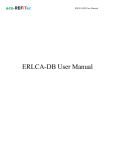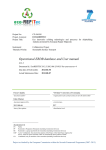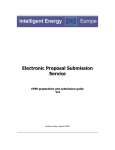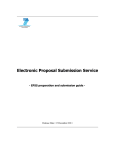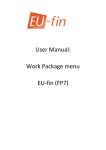Download Electronic Proposal Submission Service Vs1.3
Transcript
Electronic Proposal Submission Service EPSS preparation and submission guide Vs1.3 Release Date: June 2009 Page 1 Table of Contents 1 EPSS Preparation –User’s Guide ............................................................................. 3 1.1. Using PIC in EPSS.............................................................................................. 4 1.2 Getting a user ID and password ........................................................................... 5 1.3 Login ................................................................................................................... 8 1.3.1 Initial Login ....................................................................................................... 8 1.3.2 Subsequent Logins ............................................................................................. 8 1.4 General ................................................................................................................ 9 1.5 Proposal Setup .................................................................................................. 10 1.6 Part A ................................................................................................................. 14 1.7 Part B, Part C and Annexes................................................................................ 18 1.7.1 Part B ............................................................................................................... 19 1.7.2 Part C - Detailed Budget .................................................................................. 20 1.7.3 Annexes............................................................................................................ 21 1.8. Validation .......................................................................................................... 24 1.9. Submit Proposal ................................................................................................ 25 1.10. The History ..................................................................................................... 28 2 EPSS Checklist ...................................................................................................... 29 3 Note for Macintosh users .......................................................................................... 29 EPSS help desk Phone: +32 2 23 33 760 Email: [email protected] Page 2 1 EPSS Preparation –User’s Guide The EPSS (Electronic Proposal Submission Service) allows proposers to create their proposal completely on-line. The EPSS service is available via the internet as a web based application. The System requirements are: A connection to the Internet A screen with a 1024x768 resolution and small fonts. On-screen text size: Users should not use the font scaling option that is available with some browsers to enlarge the font size when viewing 'A forms', as this may lead to corrupted view of the forms. Internet Explorer 6.0 and above or Netscape Navigator 7.0 and above or Mozilla Firefox 1.0 and above or Opera 7.0 and above or Mac OS X Mozilla Firefox browser for Apple Macintosh users (Mac OS 9 is not supported and Safari neither) see Note on p.29 JavaScript or ActiveX controls enabled (depending on browser) Cookies enabled browser Note: the EPSS web application is best viewed with using: - Internet Explorer 6.0 (and above) - or Mozilla Firefox 1.0 (and above). - Safari is NOT supported (whatever the OS) Page 3 1.1. Using PIC in EPSS The PIC or Participant Identification Code is a unique code for identifying the participant in any stage alongside the R&D funding management process of the programmes managed by the Commission's Research DGs. Participants will not have to submit their legal and financial information (and supporting documents) each time they submit a proposal or negotiate a grant agreement, but they should just introduce their PIC. All organizations which already signed an FP7 contract with the Commission should have received a PIC, which has been communicated to all contact points for FP7 grant agreements known to the Commission. Find out within your organization who are contact points for FP7 grant agreements; they will be able to tell you what your PIC is. If you cannot find any contact point within your organization, ask the URF help desk to put you in contact with them. If your organization does not have a PIC yet, then we suggest you to get one by registering your organization in our Unique Registration Facility or URF at the following link: http://ec.europa.eu/research/participants/urf/ For more information about Unique Registration Facility including support please visit the corresponding section of CORDIS: http://cordis.europa.eu/fp7/urf _en.html After registration, the new PIC will only be active in EPSS after 48h, therefore we suggest you to make sure that you start your self registration well before the deadline of the chosen call. Once ready, you should type your PIC when asked in EPSS. Part of the legal data associated to that PIC will then be shown in order for you to verify that the PIC you are using is indeed the right one. Should you think there are errors in the data shown that might affect the eligibility of your proposal you can always remove the PIC and fill in all requested data manually as usual. Important: Applicants are able to prepare and submit their proposal (use EPSS) without the possession or without the introduction of PIC. In that case, applicants have to provide legal documents and legal entity forms as explained in the Ecoinnovation Guide for proposers, chapter III. The default format of PIC is a 9 digits numeric code without separator or special characters. In EPSS the proposal co-ordinator (who is responsible for the overall Page 4 coordination between partners) can introduce a PIC or clear a PIC for a participant. Providing the PIC implies that the proposal co-ordinator has access to this information from its own organisation or through the proposal partners' organisations. 1.2. The first step: getting a user ID and password Access is provided via the respective CIP Eco-Innovation web site (see http://ec.europa.eu/environment/eco-innovation/application_en.htm). Click on "Register", fill in the registration form and submit it. The registration form, in addition to some contact data, asks for indicating sectors addressed in CIP Eco-Innovation, title, acronym and abstract of the proposal as well as the number of participants. This information is mandatory for the registration but can be changed later in the process of proposal preparation (see also 1.3). Please do not use special characters in the registration as they will not be accepted, you will be able to use them later in the forms while you prepare the proposal. The EPSS will send you coordinators' and partners’ usernames and passwords by e-mail. Important notice: The EPSS registration email, which contains the access codes to prepare and submit the proposal, will be sent to the email address you define during the registration. This email will be sent from [email protected]. Prior to the registration you should check that this domain (epss-fp7.org) is accepted by the email server of your organization. If you do not receive this email, please check your SPAM in case it ends up there. In any case you can always contact the EPSS Helpdesk to assist you if you have not received the EPSS codes. The login and password is linked to only one proposal (for the call you have chosen). For each other proposal you want to prepare you have to register again, following the procedure described above. Note: If you have a PIC number you can already use it here. Once you obtain the EPSS account you will be still able to stop working with a PIC number if you decide so. Page 5 If you enter your PIC, and wish to see what the associated PIC data is you may click on the 'View PIC data' button. Page 6 If at that stage you object the correctness of your PIC-data or simply you decide not to use it, you can clear it by clicking the . After clearing your PIC-data (or simply if you don’t have a PIC) you should proceed with entering valid data to all mandatory fields by manual typing. Important: The login and password you receive by e-mail is specifically linked to only one proposal (for the call and for the instrument you have chosen). For any other proposal you want to prepare you have to register again, following the procedure described above. Page 7 1.3 Login 1.3.1 Initial Login As a coordinator you must use the login and password that has been sent to you by e-mail to access the EPSS. - Go to https://www.epss-fp7.org/cip-pmrp/ Introduce the Coordinator User ID Enter the Coordinator Password Change the Coordinator Password Enter the Other participant Password Change the Other participant Password Distribute the Other participant username and the modified Other participant password to your Other participants –if any. 1.3.2 Subsequent Logins - Go to https://www.epss-fp7.org/cip-pmrp/ Introduce the Coordinator- (or Other participant-) User ID Enter the modified Coordinator- (or Other participant-) Password Note: Other participants can view all proposal information but edit only their A2 form. Only the coordinator can edit all forms and upload files. Tip : Reduce typing errors: Write logins and passwords in a text programme and copy/paste them into the fields. This prevents mis-typing errors. Page 8 1.4 General Now, you may prepare the proposal. By clicking on the “General” Tab, you can find information about: - The selected call The Coordinator’s Details The proposal’s status Note: 1. If the co-ordinator details change, you do not need to register again; co-ordinator information is taken from the A2 forms, so that it is sufficient to change the details there. 2. If you wish to modify the title of the proposal you will have to do it in the forms. The title appearing in this page is taken from the registration data and cannot be changed. This does not affect the submitted proposal, because what is evaluated is the content of the A forms, Part B and Part C. Go to “Proposal setup”. Page 9 1.5 Proposal Setup In the proposal setup section you define the number of Other participants that participate in your project. You can change the amount of Other participants later, if necessary, by adding or deleting them (note that if you delete a partner, the associated A2 form and its row in A3 will be deleted as well). Note: The first participant is always the co-ordinator. The organisation short name can be max 18 characters long and cannot contain special character such as : ( ) " ' , < > $ % # & * ! / \ Make sure that the co-ordinator e-mail address is correct. If you include multiple e-mail addresses, you must separate them with a semi-colon “;” and without any space. Tip : The e-mail addresses introduced here are used by EPSS to send automatic e-mail confirmation once the proposal is submitted/transferred for evaluation. Please check that they are complete and accurate. To add another participant to the proposal, you may provide the relevant participant's PIC number and must provide a participant short name and e-mail address. If a PIC is provided then the corresponding data will be retrieved from the database once the corresponding A2 form is opened Important: You shall make sure that the responsible participant opens the corresponding A.2 form in order to finish validation. The associated PIC-data set is only inherited once the A.2 form opened. The same validation step is mandatory if the PIC number is deleted or modified. These validation steps are necessary to avoid unintended changes in the administrative data. If for some reason you decide to change or re-introduce a PIC, please Page 10 always make sure that you not only click on the 'Update Participant information' and then click on 'Accept' but afterwards you make sure that the corresponding A.2 form is opened to finish verification and have the PIC data inherited. To add another participant to the proposal, type in the Other participant's name and email address. Make sure that the numbering of participants is consistent in all Forms, also in Part B and C. Once a participant is added, the system automatically creates an A2 (Participant Information) form. This form is accessible via the A2-Link button, but can also be found after clicking in the “Part A” Tab. Page 11 You can use the button to modify data related to a participant: Page 12 Important: In order to enforce changes you must click on to update a Participant’s details. Rejection of the retrieved PIC-data If you object the accuracy of the retrieved information then you can decide to remove it by clicking on the button. If the PIC-data is cleared, than all associated information will be erased from the A.2 and A.3 forms and have to be re-entered manually again. Page 13 1.6 Part A This section deals with the administrative forms of the proposal, Part A. Part A shows the overview of forms A1, A2 and A3. Click on the links that are listed below “Form name” to access the forms. The Proposers need to fill the Part A forms online and appropriately and save them on the EPSS server. If you wish, you can also download each form as a PDF file to your hard disk. Check the relevant fields and click on “download” to receive PDF copies of the Part A forms. Note: If a participant has been added with the use of PIC, then a set of fields on the A2 form will already be pre-filled with information as retrieved from the database. Only some of these fields are editable. For a participant for whom a PIC has been provided, the first time that the A2 or A3.1 form is opened the following screen shows up: Page 14 Important! You must make sure that the responsible participant opens the corresponding A.2 form in order to finish validation. The associated PIC-data set is only inherited once the A.2 form opened. The same validation step is mandatory if the PIC number is deleted or modified. These validation steps are necessary to avoid unintended changes in the administrative data. If for some reason you decide to change or re-introduce a PIC, please always make sure that you not only click on the 'Update Participant information' and then click on 'Accept' but afterwards you make sure that the corresponding A.2 form is opened to finish verification and have the PIC data inherited.. Page 15 Form completion and validation of Part A forms: - Fill the fields with data. All fields are mandatory. Use “-“ in case text is requested or use “0” in case numbers/amounts are requested, if you wish to designate the “none” or “Non applicable” value. - Press the “Validate” button at the bottom of the form: The validation is looking for formal errors in the forms. If it finds errors, it indicates which fields are wrongly filled. - If all the necessary fields are filled correctly, you will find “no validation errors” at the bottom of the form. Page 16 Attention: Do not forget to save the form by pressing the “Save Form” button, or your changes will be discarded! Note: The “Save Form” button performs a form validation as well. Fill out all forms for which you are responsible. For the A3 form, the total amounts are automatically calculated by the system when the “Validate” button is pressed. Obviously the appropriate fields need to be completed first. Tip Save early and often. Saving will also validate the form. Pay attention to the time-out of the system: editing a form is not considered as an action of the user, saving or validating the form will reset the time-out. Page 17 1.7 Part B, Part C and Annexes Part B, the Part C - Detailed Budget as well as all required annexes can only be uploaded by the co-ordinator. You must use the templates provided at the tab "Part B, Part C and Annexes". By clicking on the "download links", the coordinator downloads not only the templates for Part B and C but also the list of required annexes as well as the template file for the simplified financial statement (xls format). Page 18 1.7.1 Part B For the proposal content (part B) you are requested to use exclusively PDF (“portable document format”, compatible with Adobe Acrobat version 5 or higher, with embedded fonts). Other file formats will not be accepted by the system. This means that you will convert your word- or RTF-document into a PDF-file before uploading. Both commercial and free tools to convert files to PDF format are widely available on the WEB. Also zipped (or otherwise compressed) archives will not be accepted (PDF is selfcompressing, there is no gain in zipping). Technical problems resulting from the use of other formats may lead to your proposal being excluded. Only one PDF file comprising the complete Part B can be uploaded. Files other than the requested ones or additional information (company brochures, supporting documentation, reports, audio, video, multimedia etc.) will be disregarded during the evaluation of the proposal. Using only PDF format for submission of Part B Why? This format for text documents is supported by the vast majority of computer platforms. The advantage of saving as a PDF file is that the contents are "locked" and the original formatting (margins, page breaks, etc.) will always be maintained when the file is printed. In addition, unlike many common document formats, there are almost no viruses associated with PDF files. Allowing proposers to submit in any possible format would require the Commission to maintain an arsenal of software in different versions - and even then readability could not be guaranteed in 100% of the cases. How? The possibility of converting a text file into PDF is integrated into some word processors. In case this is not implemented in the word processor you are using, you can download special conversion software (commercial software or downloadable freeware) from the web. Conversion into PDF is the last step in preparing a document for submission; since PDF documents are "locked", they cannot be edited like normal text files. The format and structure of part B of a proposal (the description of the content of the proposal) for the specific call is specified in the “Part B Template” file. By clicking on the link “Download Part B/Annexes Templates” the proposer downloads the template file (RTF format) and uses it as a guide to structure the proposal Part B appropriately. Open the template Part B RTF file and edit it. Save the file, and once finished convert it to PDF and then add it to the proposal. The Part B filename should contain the proposal acronym and be structured as follows: Eco-I08-ACRONYM. The file name can only contain Latin letters (a-z), digits (0-9), the underscore (_), the dash (-) and the dot (.) character. It cannot contain any special characters or spaces. If your proposal acronym contains spaces, you need to replace them in the file name, e.g. by the underscore (_). Page 19 Part B checklist: - Part B is in PDF format (compatible with Adobe Acrobat version 5 or higher, with embedded fonts) - Filename ends in .pdf - Filename does not contain any special characters or spaces - The PDF Part B must not be encrypted and the parameter that prevents printing must not be selected - The proposal contains no unnecessary coloured or high resolution pictures. It will be printed in Black and White at 300dpi for evaluation. - The PDF-file containing Part B is at a reasonable size: on average, a Part B is about 2-3 Mb. Do not upload a file larger than 10 Mb. Once the Part B file is created, use the “Browse” button to locate the part B file. Click on “Upload Proposal File” to upload the Part B file to the proposal. Tip Do not use special characters in the file name. The system will prevent you from uploading such files. 1.7.2 Part C - Detailed Budget The Part C - Detailed Budget file provides detailed information about the estimated budget and costs of the proposal, broken down to the level of participants and work packages. Each participant has to provide information to the co-ordinator, who fills the data into the Part C - Detailed Budget file. As with Part B, you are requested to use exclusively PDF (“portable document format”, compatible with Adobe Acrobat version 5 or higher, with embedded fonts) for Part C. Other file formats will not be accepted by the system. This means that you will convert your XLS-document into a PDF-file before uploading. Both commercial and free tools to convert files to PDF format are widely available on the WEB. Also zipped (or otherwise compressed) archives will not be accepted (PDF is self-compressing, there is no gain in zipping). Technical problems resulting from the use of other formats may lead to your proposal being excluded. By clicking on the link “Download Part C Budget Template” the co-ordinator downloads the template file (XLS format) and uses it as a guide to fill in the Part C - Detailed Budget section appropriately. Open the template Part C XLS file and edit it. Save the file, and once finished convert it to PDF and then add it to the proposal. The Part C - Detailed Budget filename should contain the proposal acronym and be structured as follows: Eco-I-08-ACRONYM-Budget. The file name can only contain Latin letters (a-z), digits (0-9), the underscore (_), the dash (-) and the dot (.) character. It cannot contain any Page 20 special characters or spaces. If your proposal acronym contains spaces, you need to replace them in the file name, e.g. by the underscore (_). Once Part C -is completed and created as PDF file, use the “Browse” button to locate the file you want to upload. Click on “Upload Budget File” to upload Part C to the proposal. Part C checklist: - Part C is in PDF format (compatible with Adobe Acrobat version 5 or higher, with embedded fonts) - Filename ends in .pdf - Filename does not contain any special characters or spaces - The PDF Part C must not be encrypted and the parameter that prevents printing must not be selected - The proposal contains no unnecessary coloured or high resolution pictures. It will be printed in Black and White at 300dpi for evaluation. - The PDF-file containing Part C is at a reasonable size: on average, a Part C is less than 1 Mb. In any case, do not upload a file larger than 10 Mb. 1.7.3 Annexes Further to Part A, Part B and Part C, additional annexes are required. These annexes are related to the participants, documenting for example the legal and financial situation. By clicking on the "download links", the coordinator downloads not only the templates for Part B and C but also the list of required annexes as well as the template file for the simplified financial statement (xls format). For the Annexes the only supported formats are PDF and XLS. The Annex filename should not contain any special characters or spaces. It can only contain Latin letters (a-z), digits (0-9), the underscore (_), the dash (-) and the dot (.) character and must in any case be different from the Part B filename. The file naming should follow the system indicated in the table below: Type of Annex Who needs to submit Annex format File name Legal documents (LD) Every participant who does not have a PIC PDF LD_Participantshortname Legal entity sheet (LE) Every participant who does not have a PIC PDF LE_Participantshortname Financial Statements/ private participants PDF BS_Participantshortname private participants XLS SFS_Participantshortname Balance sheets (BS) Simplified financial statement (SFS) Page 21 Financial identification form (FI) Co-ordinator PDF FI_Participantshortname Declaration by the applicant (DEC) All participants ( (the declarations of all participants must be scanned by coordinator in one file) PDF DEC_ProjectAcronym Letters of support/intent (LOI) (optional) PDF LOI_ProjectAcronym all letters of intent need to be scanned by the coordinator in one file Use the “Browse” button to locate the Annexes files. You can use the "Annexes Upload" section to locate and upload them. You should not upload any files other than those specifically requested in the Guide for proposers. Click on “Upload Annex File” to upload the annexes to the proposal. Note: In case of uploading annexes to the EPSS, please make sure that the name of the annex file is NOT identical with the name of your part B file. Otherwise your Part B will be replaced by this file! Same applies for the Part C file! Note: Before being saved to the EPSS database, the Part B, the Part C - Detailed Budget and all Annex files are checked for viruses. If files are found to be infected they are rejected by the system and the user is warned. Tip Upload your proposal early in the process and press the “submit” button and all buttons that follow in the subsequent pages. Doing this ensures that an interim version of the proposal text (the part B) is already present on the system. Remember that the system allows multiple uploads of the proposal text and this facility should be used to avoid the call closure rush. Tip In some rare instances, the proposal may be altered while in transit on the Internet. To check whether the uploaded files have been received unaltered, perform a download of the files. Tip Practice the conversion of the file to the PDF format. The conversion may take an extended period of time if the page layout is complex or contains graphics. There is no point in creating a PDF document with a resolution higher than 300 DPI and other than in black and white. Nuances of grey may be reproduced but should be avoided for legibility purposes. Upon successful upload of a file the following screen appears: Page 22 If the proposal is ready you should click on “Submit NOW” in order to submit it. If not, then click on “Submit LATER” or any other of the tabs in order to continue with its preparation. Attention: you need to complete all step for submission (see next pages) before the call deadline, otherwise your project is not counted as submitted. Modifications to proposals are possible at any time before the deadline, also after an initial submission. The latest version available at the deadline is considered as the one submitted. Page 23 1.8 Validation Select "Check Validation" and click on "next" in order to validate the entire proposal. Possible errors are indicated and can easily be found and resolved. Please note that during the validation process Errors or Warnings may be reported. It is still possible to submit a proposal, which has Warnings; it is NOT possible to submit a proposal that has Errors. If you cannot locate validation errors please contact the EPSS help desk immediately at +32 2 23 33 760 or [email protected]. Page 24 1.9 Submit Proposal In order to complete the proposal submission the co-ordinator must select the “Submit Proposal” section (in fact you are directed to this section when clicking on the “Submit NOW” button). Without submission, all the uploaded data (Forms, Part B, Annexes) are simply saved in the EPSS database without forming a proposal package and without being recognised as a submitted proposal. By clicking on the “Submit Proposal” button the following screen appears: Press on “Press this button to submit the proposal”. An automatic validation check will verify the proposal. If there are no validation errors, the following will appear: Page 25 If you receive this screen, the proposal is successfully submitted. The proposal can be modified and submitted until the closure of the call. Each subsequent submission overwrites the previously submitted version (earlier versions are not archived). If there are blocking validation errors you will not be able to submit the proposal and get a screen like the following: If there are “Warning” type of validation errors, then you can still proceed with the submission by supplying some relevant comments and click on the “Submit NOW” button: Page 26 Tip Simply uploading or modifying forms or files is not sufficient; the “submit” button (as well as the buttons on the pages that follow) needs to be pressed in order for the changes to be registered in the proposal package. Pressing the “submit” button is similar to putting the envelope in the mailbox, with the difference that files can be changed and resubmitted until the call deadline. Proposals or modifications that have not been submitted before the deadline are not transferred for evaluation. Page 27 1.10 The History By clicking on the “History” Tab, the record of all the actions performed while using the EPSS system appears. Thus it is possible for the co-ordinator to check when for example Partner 2 updated his A2 form. An example of the history record after proposal submission: And before the submission: Page 28 2 EPSS Checklist 1. Choose the Call for which you want to apply 2. Via the CIP Eco-Innovation web site (http://ec.europa.eu/environment/ecoinnovation/application_en.htm), register with EPSS in order to obtain a login and password well in advance of the call deadline. 3. Use the provided username and password to log in order to prepare and, finally, submit the proposal (https://www.epss-fp7.org/cip-pmrp/) 4. Under the "Proposal Setup"- tab, enter the participants. 5. Fill in the Part A Forms and save the forms, 6. Upload the Part B file, the Part C - Detailed Budget and the required Annexes. 7. Validate the proposal. 8. SUBMIT THE PROPOSAL! 3 Note for Macintosh users The combination of OSX and Microsoft Internet Explorer may cause problems while uploading files. The directory delimiters which Internet Explorer uses are recognized as “invalid characters” by the EPSS. Better results can be obtained using the Mozilla Firefox Browser (you can download it from http://www.mozilla.org/download.html). It handles the files without their pathname. The Safari browser is NOT supported. The Mac OS 9 is not supported. Page 29 EPSS Frequently Asked Questions (FAQ) For support please contact: EPSS Helpdesk - workdays from 08:00 to 20:00 - Phone: +32 2 23 33 760 E-mail: [email protected] A. General Questions: N.B.: For PIC-related questions please also see the relevant section on CORDIS (http://cordis.europa.eu/fp7/urf-pic_en.html) or its FAQ (http://cordis.europa.eu/fp7/urffaq_en.html). 1. 2. 3. 4. 5. 6. 7. 8. 9. 10. 11. 12. 13. 14. 15. 16. 17. 18. 19. 20. 21. 22. What are my options for submitting a proposal? What are the Minimum Requirements for using the EPSS application? What is the difference between a Coordinator and Other participants? Do I need to register to use the EPSS system? I registered for an EPSS account (I pressed on register and at the end I saw that an email was sent) but I haven't received any email so far. What can I do? What is the PIC or Participant Identification Code of my organization? How can I check whether my organization already has a PIC? How can I get a PIC? How can I use the PIC in EPSS? Can I use the PIC for all calls? Do I need to have a PIC to submit a proposal in EPSS? I have registered in URF, I got a PIC, but when using it in EPSS it tells me I have a wrong PIC. Why can't I modify the data directly in EPSS when I use a PIC? The data displayed when using my PIC is not accurate, what should I do? Why am I asked to verify and confirm the PIC associated data? How can I stop using the PIC in EPSS? I have lost my password, what should I do? How can I print a form? What will the evaluators see? Can I access EPSS directly (not via the CIP eco-innovation website)? I am in an EPSS form NOT idle, filling the fields. The system ejected me saying that I was idle for more than 30 minutes. I lost all the data I have filled in! Is that normal? I am trying to fill the forms and the online help-hints obscure the field that I need to write in. What can I do? Page 30 23. I try to open a form in PDF format that has been uploaded before and I get an error like “…Error opening document. File not found….”. What can I do? 24. I am preparing several proposals concurrently. I am using different IE7 or Firefox Tabs for the different sessions and all my sessions are mixed up! Is that normal? 25. I have validation errors in the forms, how shall I fix them? B. Coordinators: 1. 2. 3. 4. 5. 6. 7. 8. 9. 10. 11. 12. 13. 14. 15. 16. How should I proceed as a coordinator? (Roadmap) I have just registered and the system asks me to change my password. Is that normal? I uploaded a wrong Part B, is it possible to delete it? I uploaded a wrong Annex file, is it possible to delete it? Is there any limitation on the size of the uploaded files? When should I submit? During submission, the proposal validation check has failed. Can I still submit the proposal? What happens with the completed forms when I edit Other participants in the list on the page "Proposal setup"? Which file format may I use for Part B? Should I ZIP the Part B? Are there any restrictions on file names? Which format may I use for the Detailed Budget - Part C? May I annex other files? How can I check my submitted proposal? I am stuck at a specific page of EPSS. What can I do ? I have been ejected from the EPSS system. Is that normal? C. Other participants: 1. 2. 3. 4. 5. 6. How should I proceed as another participant? (Roadmap) Why can I not edit the Part A1 and A3 forms? How do I find my Part A2 form ("Participants")? I cannot upload the Part B file nor the annexes related to my organisation. Can I change my password? I am trying to login but the system does not accept my password. Page 31 Questions and Answers A. General Questions: 1. What are my options for preparing and submitting a proposal? You can prepare and submit an application only online using the EPSS system. 2. What are the minimum requirements for using the EPSS application? Proposers will access EPSS through Web Browsers. The minimum requirements are: A connection to the Internet A screen with a 1024x768 resolution and small fonts. On-screen text size: Users should not use the font scaling option that is available with some browsers to enlarge the font size when viewing 'A forms', as this may lead to corrupted view of the forms. Internet Explorer 6.0 and above or Netscape Navigator 7.0 and above or Mozilla Firefox 1.0 and above or Opera 7.0 and above or Mac OS X Mozilla Firefox browser for Apple Macintosh users (Mac OS 9 is not supported and Safari neither) see Note on p.29 JavaScript or ActiveX controls enabled (depending on browser) Cookies enabled browser 3. With respect to using the EPSS, what is the difference between a Coordinator and Other participants? Coordinators register for a specific call, define the participants of the proposal, edit electronic forms, send usernames and passwords to Other participants, upload Part B files, Part C - Detailed Budget and Annexes and, finally, they submit the proposal. Every Other participant uses a username and password, that he/she receives from the coordinator, edits his/her own form (A2) and sends his annexes to the coordinator. No participant other than the coordinator can submit the proposal. With the password received from the coordinator, every Other participant can read files which have already been uploaded to EPSS. 4. Do I need to register to use the EPSS system? Registration must be done by the coordinator. Other participants obtain from their coordinators the information necessary to access the system. Page 32 5. I registered for an EPSS account (I pressed on register and at the end I saw that an email was sent) but I haven't received any email so far. What can I do ? When you register in EPSS, an email with the coordinator and partner account is sent automatically from [email protected]. If still after a couple of hours you don't receive it, you should check your SPAM box in the case it ends up there. If it's not in the SPAM box, you should then contact the EPSS helpdesk providing some of the data you filled during the registration (e.g. the email address, or the acronym or name of the coordinator). The EPSS Helpdesk will then manually send the EPSS account to the email addresses that you will indicate. It is advised that prior to the registration you should check that the EPSS domain (epss-fp7.org) is accepted by the email server of your organization. 6. What is the PIC or Participant Identification Code of my organisation? The PIC or Participant Identification Code is a 9 digits identifier that uniquely identifies a legal entity. Participants will not have to submit their legal and financial information (and supporting documents) each time they have to submit a proposal or negotiate a grant agreement, but just their unique code - the PIC. 7. How can I check whether my organisation already has a PIC? All organisations that have an FP7 grant agreement have received a unique code (the PIC – Participant Identification Code), to be used for identifying the participant in any future proposal in the programmes managed by the "Research Directorates-General". The PIC is being communicated to all contact points for FP7 contracts known to the Commission. You will need to find out within your organisation who the contact points for FP7 contracts are; they will be able to tell you what your PIC is. If you cannot find any contact point within your organisation, then you should ask the URF help desk [email protected] to put you in contact with them. Please note that in order to avoid identity theft, neither the URF help desk nor the EPSS Helpdesk will be able to provide you with the PIC. 8. How can I get a PIC? If it is the first participation then the participant should register into the URF and submit the legal data. A PIC is provided at the end of the registration process and can be used for proposal submission after 48 hours. During registration, URF does not check for duplicate registrations; this will be done if your proposal is retained for negotiation 9. How can I use the PIC in EPSS? - If you registered your organisation, make sure that registration took place at least 48 hours before; otherwise the URF data will not be visible to EPSS (check the call deadline!) - In EPSS, type your PIC when asked; EPSS will show you part of the legal data associated to that PIC for you to check that the PIC you are using is the right one - If you think there are errors in the data shown that might affect the eligibility of your proposal (such as SME status) you can always remove the PIC and fill in the data as usual 10. Can I use the PIC for all calls? Normally – after the transition period in May 2008 - the PIC can be used for all calls. Page 33 11. Do I need to have a PIC to submit a proposal in EPSS? The use of a PIC is not compulsory for proposal submission but it is strongly recommended. 12. I have registered in URF, I got a PIC, but when using it in EPSS it tells me I have a wrong PIC. Although the legal data is directly saved in the participant database, there will be a delay of 48 Hours before that the PIC can be used and thus the data be shown in EPSS. 13. Why can't I modify the data directly in EPSS when I use a PIC? The data shown in EPSS when entering a PIC can only be changed in URF by the LEAR of the organisation. 14. The data displayed when using my PIC is not accurate, what should I do? If you think that there are errors that put in danger the eligibility of your proposal (such as the legal status of your organisation (SME, profit/non-profit, etc.) or its country of establishment), you should submit your proposal without entering the PIC by manually re-entering all the legal and financial data and providing the required documents with the Annexes (see Guide for proposers for more details). 15. Why am I asked to verify and confirm the PIC associated data? When the coordinator adds a participant in the consortium with using their PIC number, (s)he needs to make sure that the organization associated with PIC is indeed the correct one of his/her intention. For that purpose EPSS will show the principal information associated with the PIC number (i.e. the name and address of the organization), so that the coordinator can verify the selection. On the other hand, the individual participants need to verify the details of the data associated with the PIC number and decide whether they will go ahead and use it. (cfr. Questions 12 & 13 above). 16. How can I stop using the PIC in EPSS? Only the coordinator can remove a PIC associated with a partner. In that case the person responsible for filling the forms has to supply all the PIC-related data requested in the forms. 17. I have lost my password, what should I do? You have to click on the “Forgot your password?” link in order to reset it to the original one. Note that only coordinators can request new passwords. If you are a participant and forgot your password, you should contact your coordinator. 18. How can I print a form on my printer? It is not possible to print a form directly from the EPSS. You need to download the desired form first as a PDF file. To download a specific form, tick the corresponding “DOWNLOAD (PDF)” box next to the form. Then click the download button and follow the onscreen instructions. Once the form is downloaded, you will be able to print it provided you have the Adobe Acrobat Reader installed on your computer. The Adobe Acrobat Reader is available for free on the internet. Page 34 19. What will evaluators see? All proposals are printed in black and white at a resolution of 300dpi (dots per inch) before evaluation. You should download and print your proposal and check particularly the legibility of pictures and diagrams under these conditions. 20. Can I access EPSS directly (not via the CIP Eco-Innovation website)? Yes it is possible to bypass the CIP Eco-Innovation website once you have obtained a username and password. The URL to connect is: https://www.epss-fp7.org/cip-pmrp/ 21. I am in an EPSS form NOT idle filling the fields. The system ejected me saying that I was idle for more than 30 minutes. I lost all the data I have filled in! Is that normal? If the “Save” or “Validate” buttons are not pressed, the system considers the user idle because there is interaction with the system only when those buttons are pressed. Make sure that you save the form you are filling frequently to stay logged-on. 22. I am trying to fill the forms and the online help-hints obscure the field that I need to write in. What can I do? You have probably moved from one field to another using the Tab key and not the mouse. The hints appear/disappear based on the mouse movements, NOT based on the field selection. Move your mouse on the screen and the help-hint that obscures the field will disappear. 23. I try to open a form in PDF format that has been uploaded before and I get an error like “…Error opening document. File not found….” What can I do? It has been observed that certain PC configurations may lead to the inability to open online the form in PDF format. The exact reason is not yet clear, but it is probably related to the PC security policies combined with the cache settings for HTTPS sessions. A possible solution is to save the form locally on the PC in PDF format and then open it. 24. I am preparing several proposals concurrently, I am using different IE7 Tabs for the different sessions and all my sessions are mixed up! Is that normal? Due to the way that several browsers handle the cookies that are used by JAVA applications to identify user sessions, it may happen to have interference between sessions which are initiated on different tabs. Typical examples of applications that suffer from interferences are the ones that use login credentials to identify different sessions (EPSS is such an application). The browser cannot handle the different login sessions if they are opened on different Tabs; it can only differentiate them when they are opened on different browser windows. IF YOU HAVE TO PREPARE MULTIPLE PROPOSALS, YOU MUST USE DIFFERENT BROWSER WINDOWS, NOT TABS. Page 35 25. I have validation errors in the forms, how shall I fix them? At the bottom of each form the validation errors are listed. Make sure that ALL fields have values, as all of them are mandatory. If you need to introduce a value in a field that has no meaning, use the “-“ or “0” values (if the field is character or number respectively). Especially in the A3, only integer numbers are accepted, without spaces, “,” or “.”. B. Coordinators: 1. How should I proceed as a coordinator? (Roadmap) Coordinator steps: 1. Register on the CIP Eco-Innovation website for a specific call. 2. Log in to access the online EPSS. 3. Change the password for the coordinator 4. Change the password for the participants and send it together with the username to the Other participants. 5. Set up the proposal by entering the participants, their short name and email addresses. 6. Edit Part A forms. Press the "save form" button to save your information/data/input. 7. Download the templates for Part B, Part C - Detailed Budget and the Annexes. 8. Edit and upload the Part B file. 9. Edit and upload the Part C file. 10. Upload other Annexes, as required. 11. Validate proposal to ensure basic checks are satisfied. 12. Submit the proposal. 13. Logout. 2. I have just registered and the system asks me to change my password. Is that normal? Yes, the first time you log in, the system asks you to change the coordinator’s and partner’s passwords for security reasons. 3. I uploaded a wrong Part B, is it possible to delete it? You cannot delete a Part B file but you can overwrite it. If you upload another Part B file the previous one will be overwritten. Please remember that you must re-submit (press the SUBMIT button) after you have uploaded the new part B. 4. I uploaded a wrong Annex file, is it possible to delete it? Yes it is possible to delete Annex files. 5. Is there any limitation on the size of the uploaded files? In order to have a fast upload process and to avoid possible timeout errors, it is recommended not to upload very big files. To keep sizes down, make sure that your Part B file is in PDF, avoid colour and unnecessary high resolution pictures and graphs. The average size of a Part B is 2MB. You should aim to restrict your Part B to under 3MB, and under no circumstances try to upload a file larger than 10 MB. Your Part C should probably not be larger than 1 MB. Page 36 6. When should I submit? You may submit your proposal at any time before call closure. As soon as you have a consolidated version you should submit it! You may continue to improve the proposal and re-submit the improved version as often as you wish up to the call closure. The submission takes place by clicking on the “Submit” button (and all buttons that follow in the subsequent pages), simply uploading or saving data is not sufficient! Do not tempt fate by waiting until the last moment! 7. During submission the proposal validation check has failed. Can I still submit the proposal? It depends on the reasons for the failure. The proposal validation check could have warnings (e.g. non mandatory fields left blank) or errors (e.g. missing Part B, missing A forms, blank mandatory fields left blank, etc.). In the first case you can continue the proposal submission and also provide some comments regarding the warnings. In the latter case the submission is not possible unless you provide the missing file or correct/complete the missing information in the wrong/blank fields. 8. What happens with the completed forms when I edit Other participants on the page "Proposal Setup" ? Deleting a Participant: The Participant Numbers and the Participant Types remain unchanged and the order of participants is adapted. Note: when deleting a Participant, all associated Part A forms are deleted as well. For example, when deleting Partner 5, the A2 Participant 5 will also be deleted. Adding a Participant: A new Participant is added at the end of the list of participants, a new A2 is added automatically by the system. 9. Which file format may I use for Part B? For the proposal content (part B) you must use exclusively PDF (portable document format, compatible with Adobe Acrobat Reader version 5 or higher, with embedded fonts). Other file formats will not be accepted by the system. Both commercial and free tools to convert files to PDF format are widely available on the Internet. Zipped (or otherwise compressed) archives will not be accepted (PDF is selfcompressing, there is no gain in zipping). You can not split part B into several parts, only one file will be accepted. You should check the call text and guide for proposers before uploading any document. Please note that un-requested information such as company brochures, etc. will be ignored. The PDF Part B must not be encrypted and the parameter that prevents printing must not be selected. Note that only the co-ordinator can upload documents to EPSS. Any Other participant can only edit his Part A2 form online. Page 37 10. Should I ZIP the Part B? NO! PDF files are already compressed. Send the Part B only in PDF format. 11. Are there any restrictions on file names? Use only alpha-numeric characters and the “_” character. Do not use spaces and do not use any special characters such as /, \, *, punctuation characters etc. 12. Which file format may I use for the Part C - Detailed Budget? For the Part C - Detailed Budget you must use the template provided under "Download Part C Budget Template". As with Part B, you are requested to use exclusively PDF (“portable document format”, compatible with Adobe Acrobat version 5 or higher, with embedded fonts) for Part C. Other file formats will not be accepted by the system. Please note that un-requested information such as company brochures, etc. will be ignored. Note that only the co-ordinator can upload documents to EPSS. 13. May I annex other files? You should annex exactly what is requested in the call text. With the exception of the simplified financial statement, which must be submitted as an xls-file, all other annexes must be uploaded in PDF format. All templates are available for download together with the template for Part B. You find a list of requested annexes in the CIP Eco-Innovation Guide for Proposers. Note that only the co-ordinator can upload documents to EPSS. All Other participants need to send their annexes to the coordinator for upload. 14. How can I check my submitted proposal? After you have submitted, you are advised to download the proposal and print it in black and white at 300 dpi resolution – Check the result: this is how your proposal will be seen by the evaluators. 15. I am stuck at a specific page of EPSS. What can I do? Clean the Internet browser temporary files (cache) and cookies. Close your browser. Restart your session in a new Internet browser window. If the problem persists contact the EPSS Helpdesk without delay. Page 38 16. I have been ejected from the EPSS system. Is that normal? The EPSS system automatically disconnects users that have been inactive for more than 30 minutes. Being active means clicking on “buttons” (performing a validation, save or submit operation, adding or deleting participants); entering data into the electronic forms is not accounted for. You are advised to save the form early and often. If this does not explain the reason for being ejected from the system, contact the EPSS Helpdesk without delay. Page 39 C. Other participants: 1. How should I proceed as another participant? (Roadmap) Participant steps: 1. Receive username and password from the coordinator. 2. Login for accessing the EPSS. 3. Edit your Part A2 form. 4. Validate your Part A2 to ensure basic checks are satisfied. 5. Press the save form button to save your information/data/input. 6. Logout and inform the coordinator. 2. Why can I not edit the Part A1 and Part A3 forms? Individual Participants can only edit forms that apply to themselves such as A2. Only the proposal coordinator can edit all the other forms. 3. How do I find my Part A2 form ("Participants")? After logging in, navigate to the "Part A"- tab and edit the form that indicates your name as provided by the coordinator or go to the "Proposal setup"- tab and see the forms that are associated with each Participant. Only A.2 forms can be edited by the Participants. In case there is no A2 form for you, contact the coordinator to take you up in the system. 4. I cannot upload the Part B file nor the annexes related to my organisation. Only the coordinator has the permission to upload files. Other participants have to send the required annexes regarding their organisation to the coordinator. However, every Other participant can access and download all files. 5. Can I change my password? No, only the coordinator can change passwords. 6. I am trying to login but the system does not accept my password. Contact the proposal coordinator to check if he/she has changed the Other participant’s password. Page 40








































